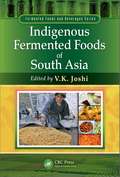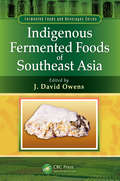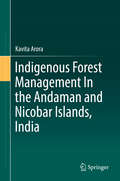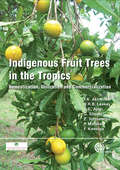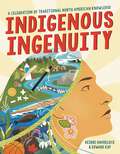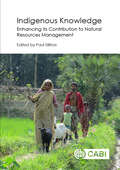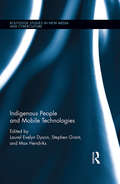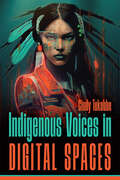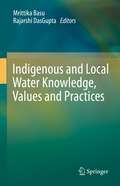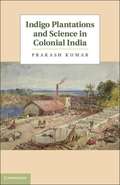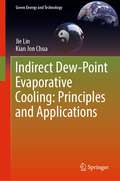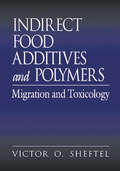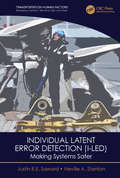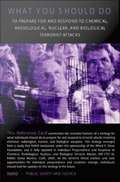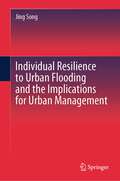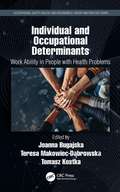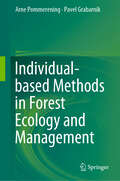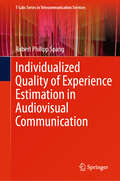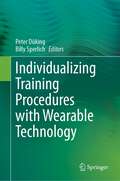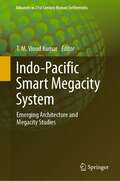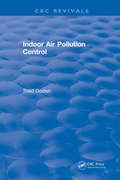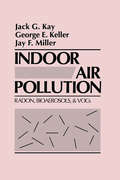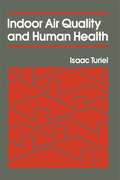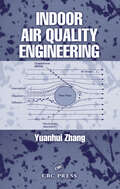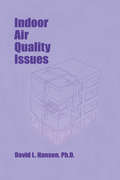- Table View
- List View
Indigenous Fermented Foods of South Asia (Fermented Foods and Beverages Series)
by V. K. JoshiIndigenous Fermented Foods of South Asia covers the foods of India, Pakistan, Bangladesh, Sri Lanka, Nepal, Bhutan, Maldives, and Afghanistan. For each type of food, its microbiology, biochemistry, biotechnology, quality, and nutritional value is covered in depth.The book discusses numerous topics including various types of fermented foods, their o
Indigenous Fermented Foods of Southeast Asia (Fermented Foods and Beverages Series)
by J. David OwensBrings Together Current Knowledge and State-of-the-Art Information on Indigenous Fermented FoodsFermented foods and beverages span a range of root crops, cereals, pulses, vegetables, nuts, fruits, and animal products. Southeast Asia has a long history of utilizing fermentation in the production and preservation of foods, and is widely recognized fo
Indigenous Forest Management In the Andaman and Nicobar Islands, India
by Kavita AroraThis book offers an extensive study of indigenous communities in the Andaman and Nicobar Islands, India, and their methods of forest conservation, along with an exploration of the impact of forestry operations in the islands and the wide scale damage they have incurred on both the land and the people. Through an in-depth analysis of the contrasting indigenous practices and governmental forestry schemes, the author has compared the modern ‘Joint Forest Management’ resolution with the ethos and practices of the indigenous people of the Andaman and Nicobar Islands. Throughout the book, readers will learn about the different indigenous communities inhabiting these islands and the treasure of knowledge each of them provide on forest conservation. The book establishes that the notion of knowledge is politicized by the dominant culture in the context of Andaman’s forest tribes, and traces how this denial of the existence of indigenous knowledge by government officials has led to reduced forest area in the region. The book also explores and analyses strategies to utilize and conserve the tribes' profound knowledge of the biodiversity of the islands and study their efforts towards forest conservation, protection and rejuvenation.
Indigenous Fruit Trees in the Tropics: Domestication, Utilization and Commercialization
by Festus K. Akinnifesi Oluyede C. Ajayi Patrick Matakala Freddie R. Kwesiga Gudeta Sileshi Zac Tchoundjeu Roger R. B. LeakeyFocusing on livestock production systems, this comprehensive text addresses how the growing diversity of global food demands will be met in the future, providing insights into new and emerging scientific areas and the implications for addressing global drivers for change.
Indigenous Ingenuity: A Celebration of Traditional North American Knowledge
by Edward Kay Deidre HavrelockCelebrate Indigenous thinkers and inventions with this beautifully designed, award-winning interactive nonfiction book—perfect for fans of Braiding Sweetgrass. <P><P>Corn. Chocolate. Fishing hooks. Boats that float. Insulated double-walled construction. Recorded history and folklore. Life-saving disinfectant. Forest fire management. Our lives would be unrecognizable without these, and countless other, scientific discoveries and technological inventions from Indigenous North Americans. Spanning topics from transportation to civil engineering, hunting technologies, astronomy, brain surgery, architecture, and agriculture, Indigenous Ingenuity is a wide-ranging STEM offering that answers the call for Indigenous nonfiction by reappropriating hidden history. <P><P>The book includes fun, simple activities and experiments that kids can do to better understand and enjoy the principles used by Indigenous inventors. Readers of all ages are invited to celebrate traditional North American Indigenous innovation, and to embrace the mindset of reciprocity, environmental responsibility, and the interconnectedness of all life.
Indigenous Knowledge: Enhancing its Contribution to Natural Resources Management (Indigenous Knowledge And Development Ser. #Vol. 39)
by David A. Cleveland Roy Ellen James Fraser James Fairhead Samara Brock Melissa Leach Christopher Shepherd Patricia Howard Johannes Lehmann Delphine Renard Daniela Soleri Andrew Ainslie Kojo Amanor Jeff Bentley Stephen Brush Luisa Cortesi Michael R Dove Romain Duda Álvaro Fernández-Llamazares Sandrine Gallois Chris Hebdon Samuel Guindo Sascha Huditz Amy Leigh Johnson Alder Keleman J Stephen Lansing Rosalinda Hidalgo Ledesma Francis Michael Ludlow Doyle McKey Citlalli López Binnqüist Paul Van Mele Tom Van Mourik Lars Otto Naess Florencia Palis Fortunata Panzo Panzo Victoria Reyes García Gede Sedana Professor Paul Sillitoe Dawit Solomon Sidi Toure Thérèse De Vet Wayan Windia Gérard ZoundjiIndigenous Knowledge (IK) reviews cutting-edge research and links theory with practice to further our understanding of this important approach's contribution to natural resource management. It addresses IK's potential in solving issues such as coping with change, ensuring global food supply for a growing population, reversing environmental degradation and promoting sustainable practices. It is increasingly recognised that IK, which has featured centrally in resource management for millennia, should play a significant part in today's programmes that seek to increase land productivity and food security while ensuring environmental conservation. By drawing together strands of biocultural diversity research into natural resources management, this book: - Provides an overview of conceptual issues around IK and its contributions to sustainable agriculture and environmental conservation; - Addresses key themes via case studies from bioculturally diverse regions of the world; - Displays a wide range of methodologies and outlines a possible agenda to guide future work. An invaluable resource for researchers and postgraduate students in environmental science and natural resources management, this book is also an informative read for development practitioners and undergraduates in agriculture, forestry, geography, anthropology and environmental studies.
Indigenous People and Mobile Technologies (Routledge Studies in New Media and Cyberculture)
by Laurel Evelyn Dyson Stephen Grant Max HendriksIn the rich tradition of mobile communication studies and new media, this volume examines how mobile technologies are being embraced by Indigenous people all over the world. As mobile phones have revolutionised society both in developed and developing countries, so Indigenous people are using mobile devices to bring their communities into the twenty-first century. The explosion of mobile devices and applications in Indigenous communities addresses issues of isolation and building an environment for the learning and sharing of knowledge, providing support for cultural and language revitalisation, and offering the means for social and economic renewal. This book explores how mobile technologies are overcoming disadvantage and the tyrannies of distance, allowing benefits to flow directly to Indigenous people and bringing wide-ranging changes to their lives. It begins with general issues and theoretical perspectives followed by empirical case studies that include the establishment of Indigenous mobile networks and practices, mobile technologies for social change and, finally, the ways in which mobile technology is being used to sustain Indigenous culture and language.
Indigenous Voices in Digital Spaces
by Cindy TekobbeIndigenous Voices in Digital Spaces applies Indigenous frameworks and epistemologies to online cultural movements through four case studies, including hashtags, memes, cryptocurrency, and digital artistry, and develops decolonizing practices for digital rhetoric, online identity work, and digital literacy practices. Tekobbe’s methods for analyzing and understanding Indigenous knowledges online center Indigenous storytelling and “thick” (broad, deep, and complex) Indigenous meaning-making. Employing this thickness to interpret Indigenous knowledge ways resists the settler-colonial logics that tend to flatten complex Indigenous concepts into one-note representations of racial stereotypes. Native Americans’ use of social media and digital platforms to support social movements uniquely constructs Indigenous identities as living, producing, and culture-making people, which confronts the commonplace, one-dimensional narrative that Indigenous North Americans either live in isolation or are people of history resigned to the long-forgotten past. Tekobbe’s methods are applicable to additional online research to break through Western paradigms of oppositional critique, the colonial power matrix embedded in hierarchical and taxonomical classification systems, and participant objectification. Indigenous Voices in Digital Spaces offers new methodological and epistemological opportunities to explore digital communities and technologies, problematizing conventional Western critique. This book is useful to instructors in Indigenous studies, internet studies, digital literacies, cultural studies, and communications, as well as Indigenous and internet studies researchers.
Indigenous and Local Water Knowledge, Values and Practices
by Rajarshi DasGupta Mrittika BasuThis book provides a knowledge base of the existing indigenous and local water knowledge, values, and practices, and how this water knowledge can be mainstreamed into the decision-making process. The book not only demonstrates the perks of using indigenous knowledge but also illustrates the barriers and gaps that should be considered while planning for mainstreaming traditional knowledge and values at a local scale. The chapters incorporate case studies from various parts of the world demonstrating how indigenous, and religious and cultural values of water have translated into water use and conservation behavior among indigenous people ensuring resource sustainability over a long period of time. There has been global attention towards combining indigenous and local knowledge with new information and innovation to attain future water security. In this regard, this book is timely, relevant, and significant as it is the first attempt, as per the best of our knowledge, to publish a book that solely addresses indigenous and local knowledge, values, and practices regarding water management, quality monitoring, use, and conservation. With increasing emphasis on the inclusion of indigenous and local knowledge into natural resource governance and conservation by international agencies like the Intergovernmental Science-Policy Platform on Biodiversity and Ecosystem Services (IPBES), the proposed book will significantly contribute to the existing knowledge base and demonstrate the importance of mainstreaming indigenous water knowledge and practices into water governance and decision making. The UN SDGs, recognizing the significance of indigenous knowledge systems, emphasized its inclusion in most aspects and principles of SDGs. Apart from direct links with SDGs like zero hunger (SDG 2), no poverty (SDG 1), and climate action (SDG 13), indigenous and local knowledge system is considered to be directly connected to clean water and sanitation (SDG 6). The book will be useful to researchers and students in the field of indigenous knowledge and education, water governance, community-level planning, and water sustainability. The book can be referred to for postgraduate courses and beyond, as well as policymakers, conservationists, non-governmental organizations, development practitioners, and local government officials.
Indigo Plantations and Science in Colonial India
by Prakash KumarPrakash Kumar documents the history of agricultural indigo, exploring the effects of nineteenth-century globalisation on this colonial industry. Charting the indigo culture from the early modern period to the twentieth century, Kumar discusses how knowledge of indigo culture thrived among peasant traditions on the Indian subcontinent in the early modern period and was then developed by Caribbean planters and French naturalists who codified this knowledge into widely disseminated texts. European planters who settled in Bengal with the establishment of British rule in the late eighteenth century drew on this information. From the nineteenth century, indigo culture became more modern, science-based and expert driven, and with the advent of a cheaper, purer synthetic indigo in 1897, indigo science crossed paths with the colonial state's effort to develop a science for agricultural development. Only at the end of the First World War, when the industrial use of synthetic indigo for textile dyeing and printing became almost universal, did the indigo industry's optimism fade away.
Indirect Dew-Point Evaporative Cooling: Principles and Applications (Green Energy and Technology)
by Kian Jon Chua Jie LinThis book systematically discusses state-of-the-art dew-point evaporative cooling and provides key insights into current research efforts and future research interests. Novel energy-efficient and environment-friendly cooling technologies are essential to reduce the sharply rising energy consumption and greenhouse gas emissions and achieve carbon neutrality. Conventional air-conditioners which adopt a vapor compression cycle are neither energy-efficient nor sustainable due to the use of compressors and chemical refrigerants, as well as their intrinsic coupling of sensible and latent cooling loads. With the merits of high energy efficiency and the ability to decouple cooling loads without using chemical refrigerants, indirect dew-point evaporative cooling provides an ideal alternative solution to air conditioning in a variety of applications. A comprehensive review of evaporative cooling and their underlying engineering challenges is included. Advanced engineering and modeling experience critical to the development of dew-point evaporative coolers are highlighted. The effective analysis techniques for dew-point evaporative coolers are documented, and their intrinsic characteristics captured by these methods are reported. Lastly, advanced dew-point evaporative cooling systems in various energy-connected applications are discussed by providing multiple case studies. Specifically targeted at HVAC engineers, thermal scientists, and energy-engineering researchers, this book will balance fundamental concepts, industrial applications, and leading-edge research. As this book provides readers with depth and breadth of coverage, it can also be used by graduate-level students in relevant fields.
Indirect Food Additives and Polymers: Migration and Toxicology
by Victor O. SheftelMore foods are now packaged in containers designed for direct cooking or heating, which encourages movement of substances into the foods. Indirect Food Additives and Polymers: Migration and Toxicology is an impressive review of basic regulatory, toxicological, and other scientific information necessary to identify, characterize, measure, and predict the hazards of nearly 2,000 of the plastic-like materials employed in packaging and identified by the FDA as indirect food additives. It presents the data underlying federal regulations, previously unavailable in one volume, and is a convenient resource for anyone working in the large number of related disciplines.
Individual Latent Error Detection: Making Systems Safer (Transportation Human Factors)
by Neville A. Stanton Justin R.E. SawardUndetected human error in aircraft maintenance creates a latent error condition that can contribute to undesirable outcomes. Individual Latent Error Detection (I-LED) acts as an additional system safety control that helps an engineer recall past errors through environmental cues. This book addresses a gap in the human factors research and current safety strategies by exploring the nature and extent of I-LED and its benefit to safety resilience. The book will describe the I-LED concept using a systems perspective and propose practical interventions to be integrated within existing safety systems as an additional control to enhance resilience against human performance variability. Provides a new view of total safety based on enhanced resilience provided through the integration of I-LED interventions within existing safety systems Offers an in-depth exploration of the phenomenon of spontaneous recall of past event, leading to error detection and recovery of latent error conditions Discusses the application of Human Factors methods to conduct real-world observations in maintenance environments Describes the application of the systems view of human error to applied research Presents cost versus benefit analysis of safety interventions targeting latent error conditions
Individual Preparedness and Response to Chemical, Radiological, Nuclear, and Biological Terrorist Attacks
by Lynn E. Davis Tom LatourretteThe guide focuses on simple steps individuals can take to prepare for and respond to terrorist attacks with chemical, biological, radiological ("dirty bomb") and nuclear weapons. The guides contain both preparatory steps and specific response guidance. This includes what individuals will experience, what their goals should be, and what they should do during each type of attack
Individual Resilience to Urban Flooding and the Implications for Urban Management
by Jing SongThis book argues that the substantial life and property loss caused by urban flooding might not be a pure result of a vulnerable physical environment-social factors, especially the individual attributes and capacities, could have pivotal roles to play in the resilience discourse as well. In light of this, this research investigates the relationship between individual resilience to urban flooding and urban management, endeavoring to identify place-responsive measures for building resilience for residents vulnerable to urban flooding.
Individual and Occupational Determinants: Work Ability in People with Health Problems (Occupational Safety, Health, and Ergonomics)
by Joanna BugajskaThere are individual and professional factors that have the greatest impact on the preservation of work ability for people of advanced age, and people with chronic health issues and disabilities. This text examines the demographic trends in the population and shows that proper functioning in their lives is only possible if people are provided with appropriate psychosocial and physical working conditions. This publication discusses physiological changes that occur with age and influence work performance. It presents the concept of applying the International Classification of Functioning, Disability and Health (ICF) in order to assess the work ability of people with disabilities. It shows, using examples and case studies, that practical activities aimed at appropriate working conditions for people of advanced age, and people with health issues and disabilities, will have excellent work ability. Features Presents a comprehensive approach to workplace tolerance for people with health issues Offers an innovated in-depth evaluation of the Work Ability Index (WAI) Presents applying the International Classification of Functioning, Disability and Health (ICF) to access the work ability of people with disabilities Outlines actions that should be taken to maintain work ability for people of advanced age or with disabilities Provides real case studies and analysis. "Demographic changes, especially those related to aging, belong to the main changes occurring in the contemporary working environment. Thus, preserving work ability in the older population as well as [populations with] health concerns are among the most important challenges of today. Accordingly, the monograph fits into the most recent issues of [this] public health area, focusing on work ability in populations at risk of social exclusion, also occupational exclusion. These are older people, persons with chronic diseases and those with different types of disabilities. In my opinion, highlighting the problem of work ability in the context of aging by the authors, in such a broad understanding, is extremely valuable and useful and the presented research outcome is an authentic and very much expected contribution to the discussion on this issue. The topic has been thoroughly presented, which undoubtedly results from the interdisciplinarity of the group of authors including specialists in work physiology, physicians and physiotherapists. The monograph provides a very measurable and reliable knowledge in this field. Combining the theory with the presentation of the authors’ research outcomes is an unquestionable advantage of the monograph…".—Jolanta Walusiak-Skorupa, Nofer Institute of Occupational Medicine, Łódź, Poland
Individual-based Methods in Forest Ecology and Management
by Arne Pommerening Pavel GrabarnikModel-driven individual-based forest ecology and individual-based methods in forest management are of increasing importance in many parts of the world. For the first time this book integrates three main fields of forest ecology and management, i.e. tree/plant interactions, biometry of plant growth and human behaviour in forests. Individual-based forest ecology and management is an interdisciplinary research field with a focus on how the individual behaviour of plants contributes to the formation of spatial patterns that evolve through time. Key to this research is a strict bottom-up approach where the shaping and characteristics of plant communities are mostly the result of interactions between plants and between plants and humans. This book unites important methods of individual-based forest ecology and management from point process statistics, individual-based modelling, plant growth science and behavioural statistics. For ease of access, better understanding and transparency the methods are accompanied by R code and worked examples.
Individualized Quality of Experience Estimation in Audiovisual Communication (T-Labs Series in Telecommunication Services)
by Robert Philipp SpangThe book presents an in-depth exploration of the Individuality Assisted Estimation (IAE) model in the context of Quality of Experience (QoE) assessment for multimedia, specifically audiovisual communication. The book delves into how individual characteristics, including psychological traits and states, influence perceptions of multimedia quality. The book argues for the integration of individual differences into these assessments, hypothesizing that this approach can enhance the accuracy and relevance of QoE ratings. Through a series of experiments and analyses, the book rigorously evaluates the effectiveness of the IAE model, comparing it against traditional methods, and highlights its particular strengths in estimating task load. The research contributes to the field by emphasizing the importance of individuality in multimedia quality assessment and offering a practical, empirically validated approach for incorporating individual differences into QoE models.
Individualizing Training Procedures with Wearable Technology
by Billy Sperlich Peter DükingThis book gives evidence-based background information and advice to athletes and coaches on if and how data from wearable technologies can be applied for preparing individual training procedures to achieve improvement on aspects of performance and health.Sports practitioners frequently make decisions on long-term training planning and daily choices on different aspects of training, recovery and therapeutic procedures. Such decisions are essential to gain optimal performance enhancement, reduce likelihood of injuries and to reach peak performance. These decisions are complexed by the fact that there is no "blue-print" training procedure applicable to all athletes, and individual characteristics need to be considered to improve training procedures. With rapid technological advancements, data from Wearable Technologies is becoming increasingly available and potentially can aid athletes and coaches to individualize and optimize training procedures. Finally, the book explores if and how data can deliver actionable insights to inform long-term and day-to-day decision making to individualize training procedure.
Indo-Pacific Smart Megacity System: Emerging Architecture and Megacity Studies (Advances in 21st Century Human Settlements)
by T. M. Vinod KumarThis book is an in-depth study of the Indo-Pacific region for effective interventions in the megacities system. First, based on several criteria, the region is identified as homogeneous country groupings of diversity, a multi-polar spatial system, and as program regions of QUAD and I2U2 for action programs and investment transcending many nations but mostly the ocean space of the Indo-Pacific, connecting all megacities sub-regions spatially and functionally. Then, the megacities with problems and prospects for economic integration are studied from the point of view of regional economics and international trade, and finally, the rural–urban interface with case studies of selected countries is presented. Prospects of systems of megacities and individual megacities for regional economies are designed. Existing interconnections through rail, air, and ocean of megacity systems, their capacity, performance, and potential are analyzed for emerging issues. International trade among the megacity systems/countries with emerging issues and barriers are presented. The mobility of money, goods, and services among the systems of megacities is analyzed. Rule-based diplomacy and other emerging options are discussed to sustain the above calls for a study of the Security of the Indo-Pacific region. Finally, the emerging architecture for megacity system governance is also presented.Out of 21 megacities in the Indo-Pacific, an in-depth study of a few in India and Japan in the Indo-Pacific region for effective economic interventions in the megacities system at the city level was studied. COVID-19 has affected most of the countries in the Indo-Pacific. With a contraction of GDP and a GDP growth rate negative, the number below the poverty level increased. Foreign Direct Investment is not forthcoming in any of these countries. Job creation becomes a priority in addition to public health concerns connected with COVID-19.
Indoor Air Pollution Control
by Thad GodishThis is an all new book designed to provide you the practical information and data you need for indoor air pollution control! Presented early in the book is theory as support for the applications that follow; including a synthesized review of the significant literature on controlling air pollution. Practical applications-largely from the author's own experience-deal with 1) How to conduct indoor air quality investigations in both residences and public access buildings, 2) Indoor air quality mitigation practice, and 3) Case histories. This book will be very useful to consultants and other professionals who grapple to solve real world problems. And it will make an excellent textbook for new courses in indoor air quality. Indoor Air Pollution Control will be used for control and prevention of contaminated air in homes, apartment buildings, office buildings (large and small), hospitals, auditoriums, and other public buildings.
Indoor Air Pollution: Radon, Bioaerosols, and VOCs
by Jack G. Kay George E. Keller Jay F. MillerIndoor Air Pollution: Radon, Bioaerosols, and VOCs covers the most current aspects of indoor pollution research, including vitally important topics such as radon, bioaerosols, and volatile organic compounds. The book presents information on microbial contamination abatement, chemical characterization of air samples, sick building syndrome, biological pollutants, liability of indoor air pollution, and measurement and control of radon. Industrial hygienists, toxicologists, safety officers, and engineers in industry and academia should consider this book a "must read" selection.
Indoor Air Quality & Human Health: Families, Social Networks, And Cultural Imperatives
by Isaac TurielFirst published in 1985. Routledge is an imprint of Taylor & Francis, an informa company.
Indoor Air Quality Engineering
by Yuanhui ZhangIndoor Air Quality Engineering covers a wide range of indoor air quality engineering principles and applications, providing guidelines for identifying and analyzing indoor air quality problems as well as designing a system to mitigate these problems. Structured into three sections - properties and behavior of airborne pollutants, measurement and sa
Indoor Air Quality Issues
by David L. HansenThis text examines problems such as microbial contamination, building design, ventilation systems and psychological effects. It uses a multi-disciplined approach in examining the causes and effects of the interactions between occupants and non-industrial environments. The text also provides the reader with a tool for diagnosing IAQ problems and effectively reducing them.
